 “Let’s see. Should I ask for a single gift or a multi-year gift?”
“Let’s see. Should I ask for a single gift or a multi-year gift?”
This is the question posed to Jeff and me and our team almost every week. Often, it’s the struggle of how to balance multi-year larger campaign solicitations with the need to be asking donors for their support multiple times a year.
How should you think about this?
To answer the question, let’s start in a different place. Let’s start with what the donor wants to do. And that boils down to a very simple reality. Through their giving, the donor wants to make a difference on the planet. At this point, I could say “nothing more than that.” But that might, in your mind, minimize what a great thing that is.
It’s important to every donor that they know that something of value happens as of result of their giving – something of value that matches their passions and interests. And if you’re providing that value with your caseload donor, the single vs. multiple year ask takes care of itself. Here is what Jeff and I mean by that:
- You’ve identified your donor’s passions and interests and figured out which ones align to your programs and projects.
- You clearly understand the costs of those programs and projects – and by costs I mean all costs: direct costs and allocated overhead.
- You’ve talked to your program and finance people and become aware of what else could be done in those programs and projects, even beyond the current budget, IF the funds were available. (Be careful on this point that you’re staying within your organization’s program criteria and funding priorities).
- You are now sitting (electronically or socially distanced) with your donor and talking about all that can be done through their giving. More than likely, what needs to be done far surpasses what they’ve ever given before. But you aren’t concerned about that point right now. Instead, you’re focused on what could be done if the funds were available. You’re squarely focused on adding value to the donor, because this is the very thing they’re very interested in.
- And now, you’re asking the donor to help make this program that she loves happen. Here’s where you ask for her participation for the whole thing, and this assumes that the donor has capacity to do it. Note that we haven’t yet arrived at the one year vs. multi-year topic.
- At this point, the donor may say no or yes to the entire amount payable now, or yes to a different amount payable right now, or yes to the entire amount payable in yearly increments. This is where the frequency and timing belongs in the discourse. NOT at the beginning – at the end.
Here’s the big point I’m making. It’s true that a donor has a limit to what they CAN give. I mean, we all have our personal economy, and it has limits. So that’s one factor. But it’s not true that a donor WILL only give so much within their means – by that I mean that they won’t necessarily give only what they gave last time. Within the context of what a donor CAN give, a donor will give way beyond what they’ve given before if they see value in what they’re giving to.
This is the key. It’s important to make sure your asks are perfectly aligned to the donor’s interests and passions. The frequency of giving comes in here. Assuming you’re aligned with their interests, the frequency of their giving (one time, multi-month, multi-year, etc.) is more about the donor’s cash flow/financial management and their perception of whether their gift is actually needed now. Those two things.
So, to give you a real example of what I’m talking about – one client of ours had a donor who was giving $300,000 a year to a program he loved. The MGO could have just stayed on that track. Instead, after prompting from us, they costed out what it would take to do the whole thing. It was six million dollars. We said: “ask the donor for the entire amount.” They did. The donor said yes, but wanted to do it in annual payments of $2 million.
This is what you say when the amount of the ask is too high for a one-time payment: “OK, would you be open to giving that amount over two years?” You’re offering terms to the amount.
This is how Jeff and I suggest you should be talking to your donors. Talk to them about what needs to be done in the area they’re interested in. Ask them to get on board with funding the entire program. And then back your way into payment terms (one time, monthly, yearly, etc.) as the final step.
Remember, donors are more focused on making a difference than they are in payment plans. (Tweet it!)
Richard







I think this is brilliant. The timing/”payment plan” is a means, not the end. How would you suggest, in an org that has few projects or programs and 90% of the funding is unrestricted/operating fund dollars, how would you suggest asking the donor to fund the entire “thing”?
Thanks so much. Really find your posts to be helpful.
Well, Mary. Not to be too simplistic, but – I would just ask them. I think you are answering your own question. If those “few projects/programs” and related expenses ARE those things that the donor is interested in then it is only a matter of packaging the ask so that you state that “this amount gets the mission of the organization funded”. And do not be tempted to break the amount down into program vs. overhead. It’s ALL used to fund the mission!